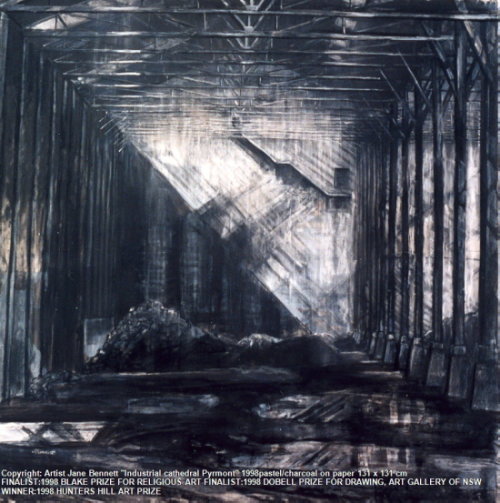I spent most of the early 2000s as ‘Artist in Residence’ on the East Darling Harbour Wharves before its redevelopment into Barangaroo.
One day in 2005 I arrived very early on a calm clear morning & a couple of wharfies grabbed me as I signed in.They were very excited & yelled “Quick, get your easel, you must paint the Norfolk Guardian- you don’t see ships like this every day!”
A smallish vessel was docking at Wharf 5. It had an oddly shaped crane in its centre, which I later found out was known as a ‘derrick’ crane as it looked similar to the old fashioned oil rigs. A Derrick ship’s crane is a relic of the past, harking back to the days before containerization forced uniformity of ship design & changed their lines from sleek to squat & boxy.
The luminous peach tones of the horizon meeting the skyline of Goat Island & the northern suburbs in the background harmonized with the butter yellow ship's crane & sky blue hull, making an odd contrast with the heavy industrial subject matter.
The luminous peach tones of the horizon meeting the skyline of Goat Island & the northern suburbs in the background harmonized with the butter yellow ship's crane & sky blue hull, making an odd contrast with the heavy industrial subject matter.
I watched the complex interplay of the ship's crane with the shore crane with a mixture of fascination & trepidation as rows of pipes were unloaded with consummate skill.
I didn't know how long I'd have to paint it before it left, so I added an extra canvas to the original one, making the total image a square.
I didn't know how long I'd have to paint it before it left, so I added an extra canvas to the original one, making the total image a square.
each panel oil on canvas 91 x 46 cm
Available for sale
The M.V. Norfolk Guardian (IMO: 8600856) is a General Cargo that was built in 1987, sailing under the flag of Tonga, & freighting break bulk cargo to Norfolk Island, New Zealand & the South Pacific. Ports of call include Norfolk Island, Auckland, Lyttleton & Marsden Point, Tasmania. Transhipments can be arranged to various destinations in the South Pacific, including Samoa, Fiji, etc.
Cargo handled by the Norfolk Guardian includes: general cargo, hazardous goods, freezer/cooler, hardwood poles, sawn timber, processed timber products.
They also ship Personal Effects from Norfolk Island & New Zealand to Yamba, Australia.
Available for sale
The M.V. Norfolk Guardian (IMO: 8600856) is a General Cargo that was built in 1987, sailing under the flag of Tonga, & freighting break bulk cargo to Norfolk Island, New Zealand & the South Pacific. Ports of call include Norfolk Island, Auckland, Lyttleton & Marsden Point, Tasmania. Transhipments can be arranged to various destinations in the South Pacific, including Samoa, Fiji, etc.
Cargo handled by the Norfolk Guardian includes: general cargo, hazardous goods, freezer/cooler, hardwood poles, sawn timber, processed timber products.
They also ship Personal Effects from Norfolk Island & New Zealand to Yamba, Australia.
"Break
bulk" is a term used for products which can't be transported in
containers. It includes a wide mix of articles- from salt, gypsum, cement to
timber, steel coils and heavy machinery as well as cars, trucks and boats.
About 50 years ago, the containerization
of shipping modified the wharves dramatically & transformed port cities beyond recognition.
The humble shipping container isn't just a metal box - it created the world as we know it today.
Once goods were loaded and transported around the world as "break bulk" cargo. Container standardization revolutionized global trade, making it easier, quicker and cheaper. However,with the advent of the container, some of the mystery & magic of the shipping industry was lost forever.
John
Crowley, the Port Operations Manager, used to describe the East Darling Harbour
Wharves (aka Port Jackson) as a ‘boutique’ wharf.
Port Botany is built on a
superhuman scale and only deals with containers, so is huge, homogeneous and
increasingly run by robots. Port Jackson, on the other hand, had a mix of
break-bulk & containers & therefore was more dependent on the personal
skills and judgement of the individual wharf workers.
Islander ships are
dwarfed by the container ships & totally unsuitable for the huge
computerized straddle cranes of Port Botany.
Now that the East Darling Harbour
Wharves are closed, most "break bulk" is unloaded at Port Kembla,
although Blackwattle Bay and to an increasingly lesser extent Glebe Island and
White Bay still handle salt, cement and gypsum.
Related Posts



No comments:
Post a Comment